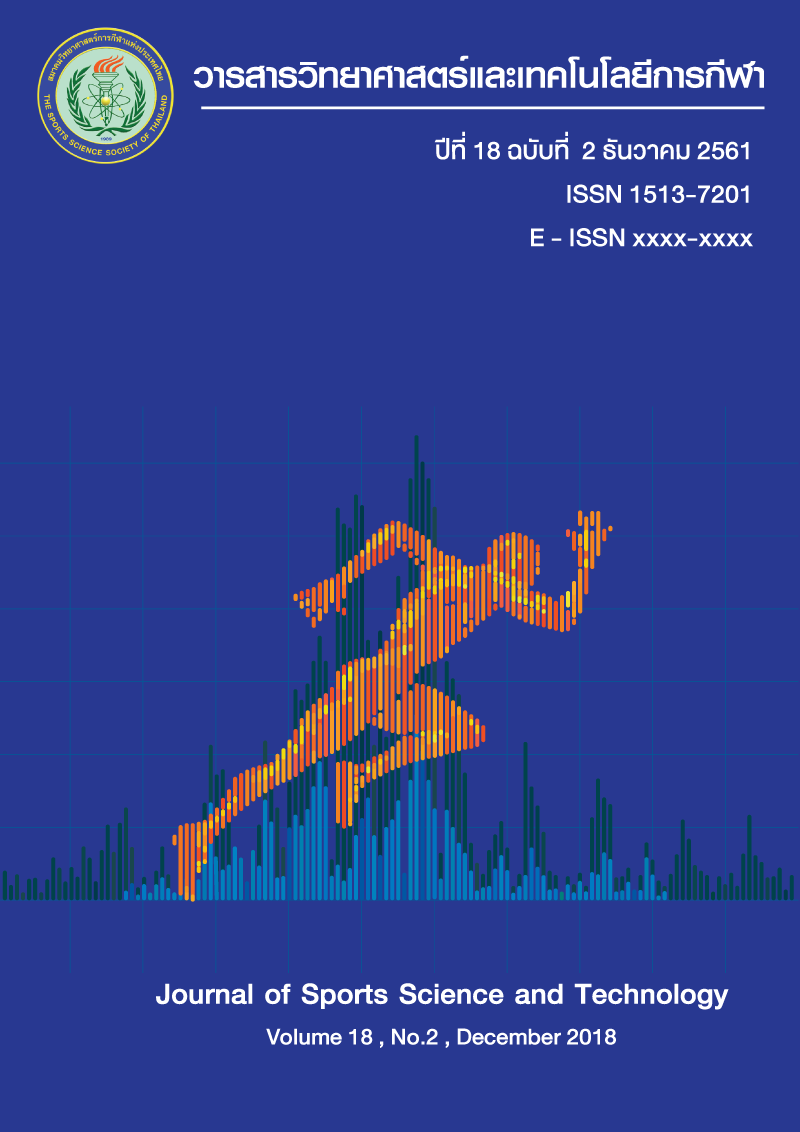A COMPARISON OF NON-EXERCISE AND EXERCISE TEST FOR ESTIMATING VO2MAX IN UNTRAINED WOMEN
Keywords:
VO2max, Prediction of maximum oxygen uptake, Oxygen ConsumptionAbstract
The purpose of this study was to compare the maximum oxygen consumption (VO2max) between program polar fitness test via the Polar RS800CX heart rate monitor watch and Astrand-Rhyming cycle ergometer test. The participants were 38 healthy untrained women volunteers with age 19.9±0.83 y, height 159.4±5.03 cm, weight 59.3±11.81 kg, respectively. The participants measured VO2max by using Polar RS800CX heart rate monitor and analyzed by the program polar fitness test (pVO2max) in supine position for 5 min. Then, they were measured VO2max immediately by using an Astrand-Rhyming cycle ergometer test (aVO2max). The result revealed that the mean for pVO2max and aVO2max were 39.8±6.58 mL·kg-1·min-1 and 41.1±3.03 mL·kg-1·min-1, respectively, which were not significantly different (p > 0.05). The correlation coefficient of pVO2max versus aVO 2max were r = 0.521 (p < 0.05), SEE = 5.69 mL·kg-1·min-1. In conclusion, the polar fitness test in the present study is recommended for estimating VO2max in healthy untrained women. However, before using the program polar fitness test, it should be study the instruction of the process for effective testing.
(Journal of Sports Science and Technology 2018; 18(2): 90- 98)
Keywords: VO2max, Prediction of maximum oxygen uptake, Oxygen Consumption
*Corresponding author: Worrawut THUWAKUM Department of Sports Science program, Faculty of science and technology, Uttaradit Rajabhat University, Uttaradit, 53000 THAILAND.
References
2. Medicine ACoS. ACSM’s guidelines for exercise testing and prescription. 6th ed. Philadelphia: Lippincott Williams & Wilkins; 2000.
3. Powers SK, Howley E. Exercise Physiology: Theory and Application to Fitness and Performance. 7th ed. New York: NY McGraw Hill; 2009.
4. Malek MH, Housh TJ, Berger DE, Coburn JW, Beck TW. A new non-exercise-based VO2max prediction equation for aerobically trained men. J Strength Cond Res. 2005;19(3):559-65.
5. Bradshaw DI, George JD, Hyde A, LaMonte MJ, Vehrs PR, Hager RL, et al. An accurate VO2max nonexercise regression model for 18-65-year-old adults. Res Q Exerc Sport. 2005;76(4):426-32.
6. Bruce RA, Kusumi F, Hosmer D. Maximal oxygen intake and nomographic assessment of functional aerobic impairment in cardiovascular disease. Am Heart J. 1973;85(4):546-62.
7. Astrand PO, Ryhming I. A nomogram for calculation of aerobic capacity (physical fitness) from pulse rate during sub-maximal work. J Appl Physiol. 1954;7(2):218-21.
8. Esco MR, Mugu EM, Williford HN, McHugh AN, Bloomquist BE. Cross-Validation of the Polar Fitness TestTM via the Polar F11 Heart. Rate Monitor in predicting VO2 Max. JEPonline 2011;14(5):31-7.
9. Crumpton S, Williford HN, O’Mailia S, Olson MS, Woolen LE. Validity of the polar M52 heart rate monitor in predicting VO2 max. Med Sci Sport Exerc 2003;35:S193.
10. Heil DP, Freedson PS, Ahlquist LE, Price J, Rippe JM. Nonexercise regression models to estimate peak oxygen consumption. Med Sci Sports Exerc 1995;27:599-606.
11. Malek MH, Housh TJ, Berger DE, Cobur JW, Beck TW. A new non-exercise based VO2 max prediction equation for aerobically trained men. J Strength Cond Res 2005;19:559-65.
12. Melanson EL, Freedson PS. The effect of endurance training on resting heart rate variability in sedentary adult males. Eur J Appl Physiol 2001;85:442-9.
13. Yamamoto K, Miyachi M, Saitoh T, Yoshioka A, Onodera S. Effects of endurance training on resting and post-exercise cardiac autonomic control. Med Sci Sports Exerc 2001;33:1496-502.
14. Hayano J, Mukai S, Sakakibara M, Okada A, Takata K, Fujinami T. Effects of respiratory interval on vagal modulation of heart rate. Am J Physiol 1994;267:H33-40.
15. Melanson EL, Freedson PS. The effect of endurance training on resting heart rate variability in sedentary adult males. Eur J Appl Physiol 2001;85:442-9.
16. Heil DP, Freedson PS, Ahlquist LE, Price J, Rippe JM. Nonexercise regression models to estimate peak oxygen consumption. Med Sci Sports Exerc 1995;27:599-606.
17. Jackson AS, Blair SN, Mahar MT, Wier LT, Ross RM, Stuteville JE. Prediction of functional aerobic capacity without exercise testing. Med Sci Sports Exerc 1990;22:863-70.
18. Wier LT, Jackson AS, Ayers GW, Arenare B. Nonexercise models for estimating VO2 max with waist girth, percent fat, or BMI. Med Sci Sports Exerc 2006;38:555-61.






